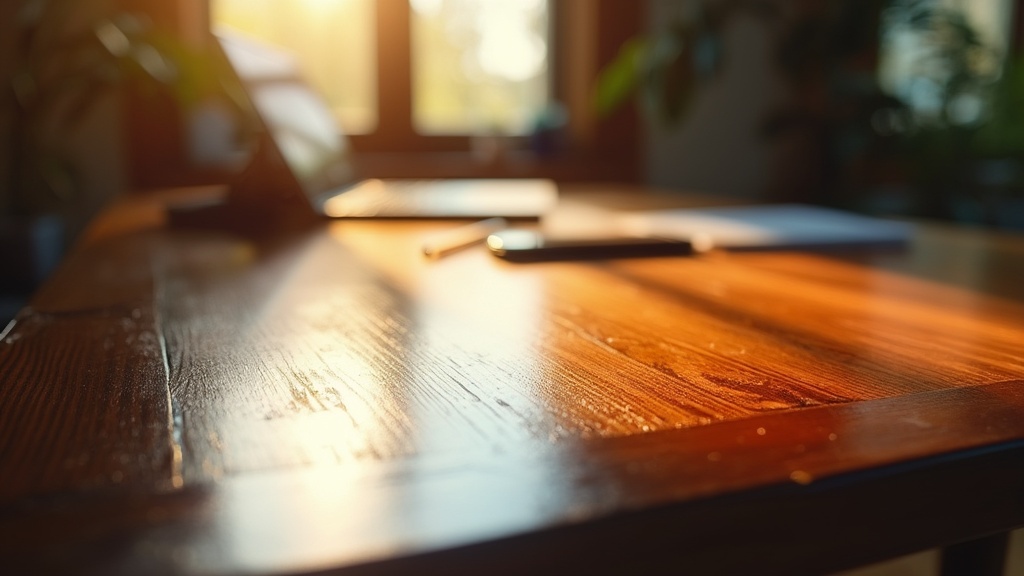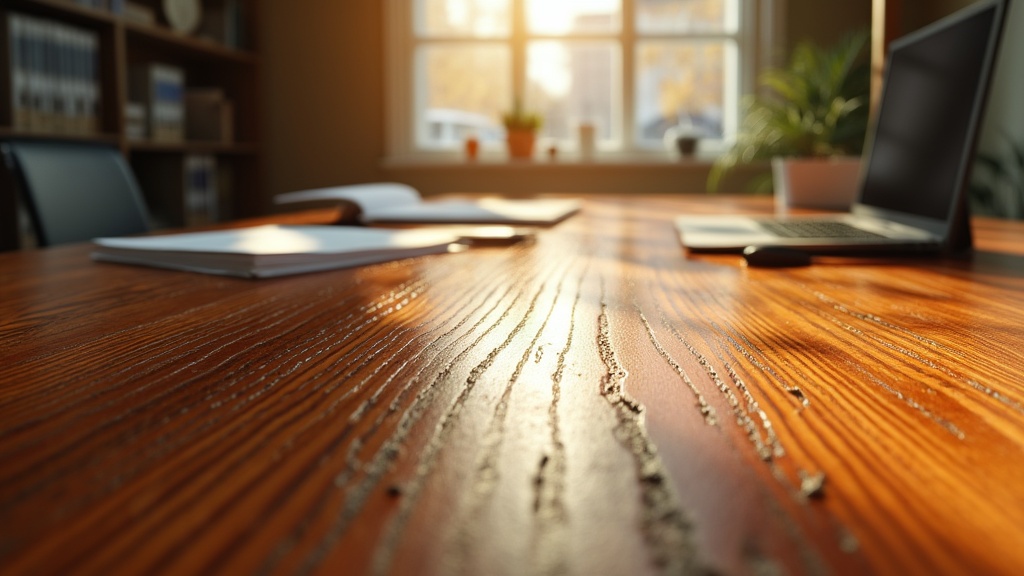Wood surfaces can enhance the aesthetic appeal of your home, but proper maintenance is essential to preserve their shine. Discovering effective DIY wood polishing tips will not only help maintain your furniture’s natural beauty but also extend its lifespan.
A widely used method involves creating a vinegar solution combined with olive oil, which acts as a natural polish that nourishes and protects various wooden surfaces.
Utilize polishing techniques by applying a polishing cloth in circular motions to ensure even distribution of the polish.
Regular furniture care contributes to restoring the sheen while preventing wear over time, ensuring your wood continues to exude luster for many years.
Click here to learn more about: how to polish wood
Choosing The Right Wood Treatment
Finding the appropriate wood treatment is essential for enhancing your furniture’s durability.
Each wood type, whether hardwood or softwood, necessitates tailored care and treatment methods. Recognizing the wood grain and ensuring the finish compatibility is vital for selecting effective products.
Eco-Friendly Treatments
For those interested in sustainable options, beeswax polish and other chemical-free treatments are excellent choices that promote environmental conservation while effectively maintaining your furniture.
These eco-friendly polishes provide robust protection without harmful chemicals.
Importance of Compatibility Testing
Before applying any wood treatment, always conduct a compatibility test on a small, inconspicuous area. This important step assesses how your chosen treatment interacts with the specific wood type, minimizing potential damage while ensuring optimal surface protection.
Taking the time to select the right treatment and performing these tests can significantly enhance the surface shine of your wood furniture, contributing to its overall beauty and longevity.

What Are Effective Polishing Techniques
Achieving a flawless finish involves employing effective polishing techniques. Surface preparation stands as a foundational step; proper cleaning and sanding create the optimal stage for achieving successful results.
Utilizing polishing pads and buffing machines can significantly improve polishing efficiency, thus making the task less labor-intensive.
Selecting the right polishing materials, such as specialized compounds and oils, can enhance your final outcomes considerably.
Recommended Tools for Polishing
- Polishing Pads: These come in various materials, designed for specific surfaces and finishes.
- Buffing Machines: Electric tools that save time and deliver a uniform finish.
- Polishing Cloths: Choose microfiber cloths to prevent scratches and improve shine quality.
When applying polish, a helpful tip is to use circular motions for uniform distribution. This technique effectively prevents swirl marks, while applying moderate pressure protects the finish from potential damage. Regular polishing frequency contributes to enhanced surface shine and longevity.
How To Achieve A Glossy Finish
Creating a glossy finish begins with effective surface cleaning methods. Cleaning wooden surfaces thoroughly—potentially using biodegradable cleaners—ensures that the wood is appropriately prepared for subsequent treatment. Familiarity with different wood finishes, such as polyurethane or lacquer, guides effective application techniques. Each finish type necessitates a tailored approach to fully optimize gloss levels.
Techniques for Optimal Shine
For a brilliant shine, utilize a microfiber cloth during buffing. Its soft texture minimizes scratch risks, which can detract from the overall luster enhancement.
The key to achieving a glossy finish lies in maintaining proper buffing technique as well as consistency throughout the process. Monitoring drying time based on the specific wood type used also influences the final outcome. Regular maintenance tips ensure longevity in furniture care and shine restoration.
Polishing Techniques
- Proper surface preparation can improve the effectiveness of polishing by up to 50%.
- Using buffing machines can reduce polishing time by more than 30% compared to manual methods.
- Microfiber cloths can absorb up to 7 times their weight in water, making them ideal for achieving a high shine without scratches.
- Regular polishing can extend the lifespan of wood finishes by preventing wear and maintaining their appearance.
Understanding Wood Grain Direction
Grain direction impacts how wood treatments interact with surfaces significantly. Different wood types possess unique grain patterns that can absorb finishes unevenly, ultimately influencing the aesthetic results.
For instance, a pronounced grain structure may enhance the beauty of a natural polish while affecting the way oils penetrate the surface.
Applying treatments along the wood grain is essential as it prevents blotchiness, ensuring a smoother finish.
To easily determine grain direction, run your hand over the wood; the smoothest angle indicates the grain. This practical tip supports achieving an attractive final appearance and enhances the overall wood care process.
Tips For Dust Removal Before Polishing
Effective dust removal is imperative for achieving a flawless finish on wood surfaces.
Ensuring that surfaces are free from debris before treatment enhances the results of any wood finishing efforts. Common tools utilized include microfiber cloths, which are excellent for attracting and holding dust particles effectively.
In addition, vacuum cleaners work well for larger areas, ensuring a thorough cleaning process.
Using a tack cloth proves beneficial since it is designed to trap dust without leaving any residue behind.
By prioritizing dust removal before polishing, you guarantee a smooth, even application of your preferred finishes.
Wood Treatment and Dust Removal
- Wood grain direction affects how treatments absorb, influencing the final appearance.
- Microfiber cloths can capture up to 99% of dust particles, making them ideal for cleaning wood surfaces.
- Using a tack cloth can significantly reduce the risk of dust settling on surfaces before finishing.
- Proper dust removal can enhance the longevity and durability of wood finishes.
Benefits Of Homemade Polish Solutions
Homemade polish solutions offer several advantages for those interested in wood care. First, cost-effectiveness plays a significant role—many recipes draw from items already found in your pantry, thereby saving money compared to commercial options.
Additionally, customization allows for adjustments based on wood types and personal preferences, creating unique solutions tailored to specific needs.
For a basic recipe, mix 1 cup of olive oil with 1/2 cup of white vinegar and 10-15 drops of essential oil for scent.
This ecofriendly polish not only improves the surface shine of wood but also promotes a healthier indoor environment.
Maintaining Shine Quality With Regular Care
Consistent routines significantly contribute to maintaining the shine on your wood surfaces. Implementing regular cleaning practices prevents dullness over time; using a soft cloth for dust removal is essential as it protects the finish from abrasive damage.
To maintain optimal shine quality and provide a protective coating, reapplying homemade polish every 1-3 months can yield remarkable results.
Scheduling Tips
Consider setting reminders on your calendar for maintenance checks every three months.
This simple scheduling tip enables proactive furniture maintenance, ensuring that you preserve the beauty and longevity of your wooden pieces.
Regular routines are key to effective furniture care, ultimately enhancing their overall appearance over time.
Homemade Polish Solutions
- Homemade polish can save up to 50% compared to commercial wood polish products.
- Using natural ingredients like olive oil and vinegar is safer for indoor air quality.
- Regular maintenance can extend the life of wooden furniture by several years.
- Essential oils not only add fragrance but can also have antibacterial properties.
Essential Oils For Natural Wood Care
Integrating essential oils into wood care routines presents an eco-friendly solution that not only enhances aesthetics but also improves durability. Specific oils, such as tea tree oil and cedarwood oil, deliver remarkable preservation benefits, effectively replacing the need for harmful chemicals.
These essential oils are recognized for their antifungal and antibacterial properties, which safeguard against rot and pests, ensuring wooden surfaces remain unscathed.
Best Essential Oils for Wood Preservation
Among the numerous options available, oils like lavender oil and lemon oil are also noteworthy.
Lemon oil not only imparts a refreshing scent but also helps in cleaning wooden surfaces and enhancing shine.
“Using a blend of these oils can elevate your wood treatment. ”
Blending Essential Oils with Carrier Substances
For the most effective wood treatment, it is advisable to blend essential oils with carrier substances. This method not only boosts absorption but also ensures moisture retention.
Mixing 3-5 drops of your chosen essential oil with a tablespoon of jojoba oil or coconut oil creates a protective coating, resulting in a beautiful, lustrous surface. This combination not only preserves wood but also enriches its inherent beauty.
Proper application techniques can further enhance the longevity of the finish.
Essential Oils for Wood Care
- Tea tree oil and cedarwood oil provide antifungal and antibacterial properties that protect wood from rot and pests.
- Lemon oil not only cleans wooden surfaces but also enhances their shine and adds a pleasant fragrance.
- Blending essential oils with carrier substances like jojoba or coconut oil improves absorption and moisture retention for better wood preservation.
- Proper application techniques can significantly extend the longevity of the wood finish.
Furniture Polishing Methods Enhance Your Home
How To Polish Wood Furniture Effectively


